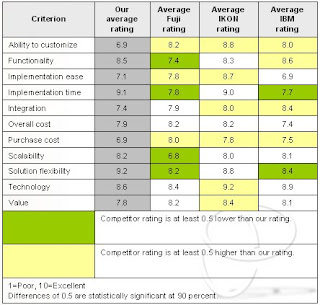Where are the Innovators in Competitive Intelligence?
So, I receive a daily alert on various competitive intelligence topics through Google’s Blog alert service. You probably track any number of topics (including the competition) by the same means (either in news, blog or regular search alerts). I like to track the “chatter” of the competitive intelligence community. I’ll also admit that I’m a little vain. I like to make sure that my blog entries make it into the top 5 each day. It took a while and a lot of consistent work to gain Google credibility, but we’re pretty visible now.
Everyday for the past year, I have received an email with at least 5 competitive intelligence topics which were generated that day. Occasionally, a rare treat will present itself in the form of a bit of information that makes me think. Mostly, I see article after article (day after day) about how the internet makes competitive intelligence possible for companies. Specifically, you should look at your competitor’s website and grab all of the information you can.
There is nothing wrong with this advice. Many competitive intelligence initiatives begin at that very spot. But, I’m a little bit surprised at how consistently some of the simplest techniques appear at the top of the searches each day.
If it isn’t “Watch your competitor’s web page,” it’s “Do a patent search.” Again, good advice, but I’m still surprised at how many people seem to come up with that idea each day and profess the practice as the next big development in competitive intelligence.
And, the whole web analytics field believes that they have reinvented the competitive intelligence field, simply by tracking Alexa traffic ratings. I’ll bet I see a couple of blog posts about that every week.
I sure do wish that the innovators in Competitive Intelligence were publishing more thoughts and creating more dialogue in the blog community. Of course, SCIP does their part to produce articles and thought leadership, but too few practitioners are participating in the blog world.
I will recommend a few of the blogs that I enjoy. Some of them are published more often than others, but they all come from very intelligent people who have a track record of sharing valuable insight.
I know I’m missing a ton. Hopefully, you’ll help fill in the blanks with your comments. And, I have included some of our competitors. In fact, I am happy to include them. There are some smart people out there and their thoughts should be promoted above the din.
These people are developing new ideas and sharing them with the CI community. These are the people that will move the industry forward. And, I sure do wish that their intelligence, creativity and insight would drown out some of the drivel that currently exists.
Hopefully, my thoughts, expressed on behalf of Primary Intelligence, have provides some level of quality or inspiration. There are so many topics that need to be covered in competitive intelligence. Hopefully, we’ll hear more about key issues and less about the “new technique” of surfing your competitors’ websites.


















